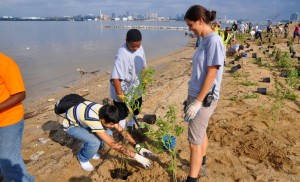Thanks to an alumna scientist, Eastern Mennonite University was among the first schools involved in groundbreaking work that is raising awareness about institutional nitrogen footprints.
Laura Cattell Noll ’09, a graduate student in environmental sciences at the University of Virginia, works with Professor James Galloway and project manager Elizabeth Castner on the “N-Print” project and helped to connect EMU.
In addition to boosting awareness about nitrogen, the internationally supported project provides suggestions for reducing nitrogen pollution and provides institutions with targets for their reduction levels. UVA was the first to develop an institution-level model for measuring nitrogen footprints and began measurements in 2010. It aims to reduce its nitrogen levels 25 percent by 2025.
An initial cohort of six other institutions—including EMU along with Brown University, Colorado State University, Dickinson College, the University of New Hampshire and the Marine Biological Laboratory in Massachusetts—joined UVA in calculating their nitrogen usage.
A second cohort group has since started, and a third is preparing to begin.
The opportunity to participate in the research was one that sustainability coordinator Jonathan Lantz-Trissel couldn’t pass up.

“This was a great ‘Aha!’ to learn more about nitrogen and share with this community and to give me a chance to do some research about food usage on campus and to talk to dining services about food consumption,” he says.
Cattell Noll, a former member of Earthkeepers, was delighted that her alma mater participated.
“When EMU agreed to participate in the first cohort of schools to test the Institution Nitrogen Footprint Tool, I was thrilled to connect my current research with my efforts as an undergraduate,” says Cattell Noll, an environmental science major who was active in EMU’s sustainability programs. “It’s been fantastic to see how the addition of a nitrogen footprint has enhanced EMU’s sustainability efforts and improved our understanding of institutional sustainability.”
[Read more about Cattell Noll’s former job with The National Aquarium.]
Nitrogen and carbon footprints equally important
Carbon footprints have received increasing attention as an environmental issue in recent years, but nitrogen has mostly flown under the radar—until now.
“Human activities have dramatically altered the nitrogen cycle over the past century,” says Castner, N Footprint Project Manager in the UVA’s Department of Environmental Sciences. “Nitrogen is essential for supporting a growing global population, but excess nitrogen has detrimental effects on the environment.”
Castner says the impacts of nitrogen “are not as simple to communicate” as those of carbon footprints, “but they are equally important.”
Among those effects, she says, are smog in urban areas, depletion of the ozone layer, acidification of aquatic systems, algae blooms, further build-up of greenhouse gases and forest mortality. At issue is not the inert nitrogen that naturally occurs in earth’s atmosphere but “reactive nitrogen”—biologically and chemically active forms that interact with the environment in damaging ways. Human activities add nearly triple the amount of nitrogen annually than what would naturally occur.
Research involves dining services
Lantz-Trissel, in his position since 2010, is familiar with tracking EMU’s carbon footprint. It’s one of the responsibilities of his position and he’s helped EMU achieve recognition for its efforts.
But a nitrogen footprint is different. It’s only recently that individuals have been able to track their own nitrogen footprint through the N-Calculator, launched in February 2011. Food production and consumption and energy usage are the biggest contributors.
EMU began its nitrogen measurements about two years ago, according to Lantz-Trissel. He says the inclusion of food as a key factor was particularly interesting.
“I’m intrigued, because I think food is a great discussion point for sustainability in all its complicated facets,” Lantz-Trissel says. “It hits energy use, fertilizers, transportation, social justice, environmental racism, workers’ rights and more.”
He says food services director Bruce Emmerson and his staff have been a great help in going through food purchases and other data to come up with numbers to enter into the calculator. Several students have also been helping with the research. EMU hasn’t set a formal goal for its nitrogen footprint yet, but Lantz-Trissel says the university has a head start.
“While EMU needs to continue to work hard to reduce our nitrogen footprint, we’re a good ways ahead,” he says. “We have the lowest amount of nitrogen per person among participating institutions. We’re doing a lot of great things already.”

Fantastic. Thank you EMU for committing to sustainability.
So glad you’re onto this. Keep educating us about all this. How do we reduce our N print?